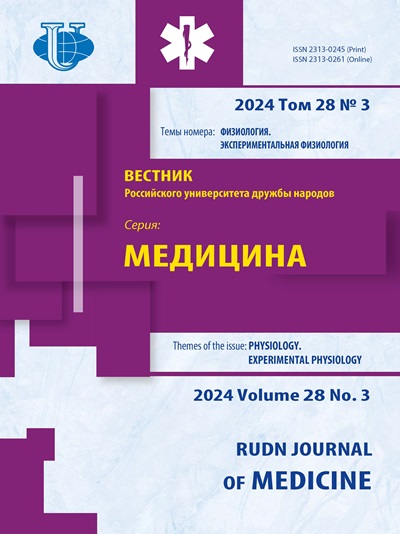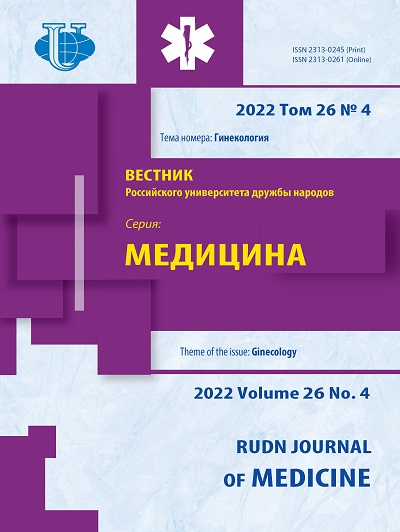Связь между максимальной аэробной способностью и вариабельностью сердечного ритма
- Авторы: Шайни Р.1, Какер С.1, Гупта Р.1, Рао А.1
-
Учреждения:
- RUHS Колледж медицинских наук
- Выпуск: Том 26, № 4 (2022): ГИНЕКОЛОГИЯ
- Страницы: 441-450
- Раздел: Физиология
- URL: https://journals.rudn.ru/medicine/article/view/32997
- DOI: https://doi.org/10.22363/2313-0245-2022-26-4-441-450
Цитировать
Полный текст
Аннотация
Актуальность. Сердечно-сосудистый статус можно оценить по максимальной аэробной емкости (VO2max) путем прямого анализа газов, участвующих в легочной вентиляции и наблюдения за колебаниями интервалов между сокращениями во времени как вариабельностью сердечного ритма. Целью исследования было изучение взаимосвязи между VO2max и вариабельностью сердечного ритма у молодых людей. Материалы и методы . В обсервационное исследование было включено 100 молодых людей в возрасте от 18 до 25 лет, которые не занимались какой-либо тяжелой физической деятельностью, 50 из которых были мужчинами и 50 женщинами. Измерялась вариабельность сердечного ритма в частотной области; НЧ, ВЧ, НЧ/ВЧ и временная область; SDNN, RMSSD, pNN 50 и VO2max оценивали с помощью теста на беговой дорожке в соответствии с протоколом поэтапных упражнений. Результаты и обсуждение . Отмечена слабая положительная корреляция VO2max с LF ( r = 0,177) и слабая отрицательная корреляция с HF ( r = -0,141). У участников мужского пола была слабая отрицательная связь между VO2max и LF ( r = -0,075), тогда как у респондентов женского пола была слабая положительная связь ( r = 0,286). Отрицательная корреляция VO2max с соотношением LF/HF была слабой у мужчин и слабой положительной корреляцией ( r = -0,101) у женщин. Для участников мужского и женского пола наблюдалась слабая отрицательная связь VO2max с SDNN ( r = -0,170) и ( r = -0,301) соответственно. Участники мужского и женского пола имели слабую отрицательную связь VO2max с RMSSD, с ( r = -0,154) и ( r = -0,284) соответственно. У участников мужского и женского пола была небольшая отрицательная связь VO2max с pNN 50 с ( r = -0,062) и ( r = -0,441) соответственно. Вывод. Значительные вариации были обнаружены во временной и частотной областях, включая HF и отношение LF/HF, которое представляет собой баланс между симпатическими и парасимпатическими ответами.
Об авторах
Р. Шайни
RUHS Колледж медицинских наук
Автор, ответственный за переписку.
Email: sainiravi414@gmail.com
ORCID iD: 0000-0001-8154-9385
г. Джайпур, Раджастхан, Индия
С. Какер
RUHS Колледж медицинских наук
Email: sainiravi414@gmail.com
ORCID iD: 0000-0002-6505-4216
г. Джайпур, Раджастхан, Индия
Р. Гупта
RUHS Колледж медицинских наук
Email: sainiravi414@gmail.com
ORCID iD: 0000-0002-5932-6764
г. Джайпур, Раджастхан, Индия
А. Рао
RUHS Колледж медицинских наук
Email: sainiravi414@gmail.com
ORCID iD: 0000-0002-0343-5777
г. Джайпур, Раджастхан, Индия
Список литературы
- Shephard RJ, Allen C, Benade AJ, Davies CT, Di Prampero PE, Merriman JE, Myhre K, Simmons R. The maximum oxygen intake. An international reference standard of cardio respiratory fitness. Bull World Health Organ. 1968;38(5):757-64.
- Ferrae K, Evans H, Smith A, Parfitt G, Eston R et. A systematic review and Meta-analysis of sub-maximal Exercise-based Equations to predict Maximal oxygen uptake in young people. J of Pediatric Exer Sci. 2014;26(10):342-57. doi: 10.1123/pes.2013-0153
- Moh H. Malek, Jared W. Coburn. Strategies for Cardiopulmonary Exercise Testing of Pectus Excavatum Patients. CLINICS. 2008;63(2):245-54.
- Lear SA, Brozic A, Myers JN, Ignaszewski A. Exercise Stress Testing An Overview of Current Guidelines. Sports Med. 1999;27(5):285-312. doi: 10.2165/00007256-199927050-00002
- Carter J G, Brooks K A, Sparks JR et. Comparison of the YMCA cycle sub-maximal VO2 max test to a treadmill VO2 max test. Int Journal of Exercise Science. 2011; 5 (11) 121-29.
- Stinton P, Tinker J, Vicker JC, Vahl SP. The scattergram: a new method for continuous electrocardiographic monitoring. Cardiovas Res. 1972;6:598-04.
- Task Force Report. Heart rate variability: standards of measurement, physiological interpretation, and clinical use. Circulation. 1996;93:1043-65.
- Shaffer F, McCraty R, Zerr CL. A healthy heart is not a metronome: an integrative review of the heart’s anatomy and heart rate variability. Front Psychol. 2014; 5:1040.
- McCraty R, Shaffer F. Heart rate variability: new perspectives on physiological mechanisms, assessment of self-regulatory capacity, and health risk. Glob Adv Health Med. 2015;4:46-61.
- Grossman P, Taylor EW. Toward understanding respiratory sinus arrhythmia: relations to cardiac vagal tone, evolution and biobehavioral functions. Biol Psychol. 2007;74:263-85.
- Kleiger RE, Bigger JT, Bosner MS, Chung MK, Cook JR, Rolnitzky LM, Steinman R, Fleiss JL. Stability over time of variables measuring heart rate variability in normal subjects. Am J Cardiol. 1991; 68: 626-30. 10.1016/0002-9149(91)90355-o
- Sacha J, Barabach S, Statkiewicz-Barabach G, Sacha K, Muller A, Piskorski J, Barthel P, Schmidt G. How to strengthen or weaken HRV dependence on heart rate- description of the method and its perspectives. Int. J. Cardiol. 2013;168:1660-63. doi: 10.1016/j.ijcard.2013.03.038
- León-Ariza1 HH, Botero-Rosas DA, Zea-Robles AC. Heart rate variability and body composition as VO2MAX determinants. Revista Brasileira de Medicina do Esporte. 2017; 23:317-321. doi: 10.1590/1517-869220172304152157.
- Buttar KK, Saboo N, Kacker S. Maximum Oxygen Consumption (VO2 max) Estimation using Direct and Indirect Method in Indian Population: A Pilot Study. Journal of Clinical and Diagnostic Research. 2020;14(2): CC 06-CC 08.
- Hellebrandt FA, Franseen EB. Physiological study of the vertical stance of man. Phys Rev.1943;23(3): 220-55.
- Currens JH. A comparison of the blood pressure in the lying and the standing positions: a study of five hundred man and five hundred women. Am. Heart J. 1948; 35: 646-54. doi: 10.1016/0002- 8703(48)90650-4
- Beltz NM, Gibson AL, Janot JM, Kravitz L, Mermier CM, Dalleck LC. «Graded Exercise Testing Protocols for the Determination of VO2max: Historical Perspectives, Progress, and Future Considerations». J of Sports Med. 2016; Article ID 3968393.
- Loe H, Rognmo O, Saltin B, Wisloff U. Aerobic Capacity Reference Data in 3816 Healthy Men and Women 20-90 Years. Plos one. 2013;8(5): e64319.
- Perez-Gomez J, Rodriguez GV, Ara I, Olmedillas H, Chavarren J, González-Henriquez JJ, Dorado C, Calbet JA. Role of muscle mass on sprint performance: gender differences. Eur J Appl Physiol. 2008; 102 (6): 685-94.
- Sammito S, Böckelmann I. Reference values for time- and frequency-domain heart rate vari-ability measures. Heart Rhythm. 2016;13(6): 1309-16.
- Dantas EM, Kemp AH, Andreão RV, da Silva VJD, Brunoni AR, Hoshi RA, Bensenor IM, Lotufo PA, Ribeiro ALP, Mill JG. Reference values for short-term resting-state heart rate variability in healthy adults: Results from the Brazilian Longitudinal Study of Adult Health, ELSA-Brasil study. Psycho-physiol. 2018;55(6): e13052.
- Grant CC, Clark JR, Janse van Rensburg DC, Viljoen M. Relationship between exercise capacity and heart rate variability: supine and in response to an orthostatic stressor. Auton Neurosci. 2009;151(2):186-8. doi: 10.1016/j.autneu.2009.08.015
- Grossman P, Taylor EW. Toward understanding respiratory sinus arrhythmia: relations to cardiac vagal tone, evolution and biobehavioral functions. Biol Psychol. 2007;74:263-85.
- Voss A, Schroeder R, Heitmann A, Peters A, Perz S. Shortterm heart rate variability-influence of gender and age in healthy subjects. PLoS One. 2015;10(3): e0118308.
- Geovanini GR, Vasques ER, de Oliveira Alvim R, Mill JG, Andreão RV, Vasques BK, Pereira AC, Krieger JE. Age and Sex Differences in Heart Rate Variability and Vagal Specific Patterns - Baependi Heart Study. Global Heart. 2020;15(1): 71.
- Yamamoto K, Miyachi M, Saitoh T, Yoshioka A, Onodera S. Effects of endurance training on resting and postexercise cardiac autonomic control. Med & Sci in Sports & Exer. 2001;33(9):1496-02.
- Gilder M, Ramsbottom R. Change in heart rate variability following orthostasis relates to volume of exercise in healthy woman. Aut. Neurosci. 2008;143:73-76.
- Nakamura Y, Yamamoto Y, Muraoka I. Autonomic control of heart rate during physical exercise and fractal dimension of heart rate variability. The American physiol society.1993; 74(2): 875-81.
















